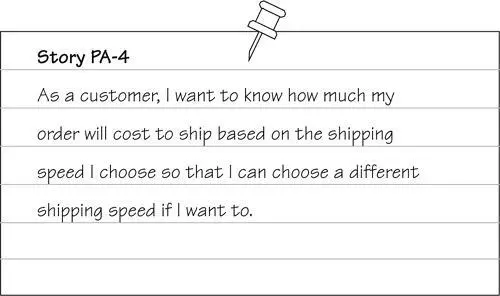Crispin, Lisa - Agile Testing - A Practical Guide for Testers and Agile Teams
Здесь есть возможность читать онлайн «Crispin, Lisa - Agile Testing - A Practical Guide for Testers and Agile Teams» весь текст электронной книги совершенно бесплатно (целиком полную версию без сокращений). В некоторых случаях можно слушать аудио, скачать через торрент в формате fb2 и присутствует краткое содержание. Год выпуска: 2008, Издательство: Addison-Wesley Professional, Жанр: Старинная литература, на английском языке. Описание произведения, (предисловие) а так же отзывы посетителей доступны на портале библиотеки ЛибКат.
- Название:Agile Testing: A Practical Guide for Testers and Agile Teams
- Автор:
- Издательство:Addison-Wesley Professional
- Жанр:
- Год:2008
- ISBN:нет данных
- Рейтинг книги:4 / 5. Голосов: 1
-
Избранное:Добавить в избранное
- Отзывы:
-
Ваша оценка:
- 80
- 1
- 2
- 3
- 4
- 5
Agile Testing: A Practical Guide for Testers and Agile Teams: краткое содержание, описание и аннотация
Предлагаем к чтению аннотацию, описание, краткое содержание или предисловие (зависит от того, что написал сам автор книги «Agile Testing: A Practical Guide for Testers and Agile Teams»). Если вы не нашли необходимую информацию о книге — напишите в комментариях, мы постараемся отыскать её.
Agile Testing: A Practical Guide for Testers and Agile Teams — читать онлайн бесплатно полную книгу (весь текст) целиком
Ниже представлен текст книги, разбитый по страницам. Система сохранения места последней прочитанной страницы, позволяет с удобством читать онлайн бесплатно книгу «Agile Testing: A Practical Guide for Testers and Agile Teams», без необходимости каждый раз заново искать на чём Вы остановились. Поставьте закладку, и сможете в любой момент перейти на страницу, на которой закончили чтение.
Интервал:
Закладка:
The ScrumMaster calls for an estimate. The team understands they’re sizing only the basic story for deleting items, not for doing something else with the deleted items. They quickly agree on a point value.
Let’s look at another story. (See Figure 15-3.)
Figure 15-3 Story on shipping speed

Tester:“What are the shipping speeds the user can choose?”
Product Owner:“Standard 5-day, 2-day, and next-day.”
Programmer:“We should probably start by only offering one speed, and calculating that cost. Then we can easily implement the other two speeds.”
Product Owner:“It’s fine to break it up like that.”
Tester:“Will we use BigExpressShipping’s API to calculate cost based on weight and destination?”
Programmer:“That would be the easiest.”
The team holds up their point cards. The tester and one of the programmers hold up an 8; the other developers hold up a 5.
ScrumMaster:“Why did you two choose 8?”
Tester:“We’ve never used BigExpressShipping’s cost API before, and I’m not sure how that will impact our testing. We have to find out how to access their system for testing.”
Other Programmer with 8:“I agree, I think the testing effort is more intense than the coding effort for this story.”
The team agrees to size the story as eight points.
This sizing process may occur before the planning meeting, and if the stories were sized or estimated a long time ago, the team might want to make sure they feel comfortable with the story sizes. Teams may have changed or may be more experienced. Either of those factors can make a team change the estimates.
There are many times when a story will have a large testing component, and the coding effort is small. At other times, the reverse will be true. It’s important to consider all perspectives.
Lisa’s Story
Our team grew to dread story sizing meetings, because we got into overly long discussions about details, and the meetings always lasted long past the scheduled time. Since then, our ScrumMaster has found ways to keep us on track. She uses an egg timer to time discussions, and stops them each time the sand runs out to see if we think we really need more time to ask questions. Our product owner has also learned what information we need for estimating and usually has what we need. We also learned to only work on stories that were likely to come up in the next few iterations.
With all of our meetings, little traditions have grown to make the meetings more fun. Someone always brings treats to iteration planning meetings. In stand-up meetings, we pass around a combination penlight and laser pointer, so each of us holds it as we report on what we’re working on. We always end story sizing meetings with a competition to see who can throw his or her deck of planning poker cards into the small plastic tub where they live. Figure 15-4 shows this goofy but fun meeting-ending activity. Always remember the agile value of enjoyment and have some fun with your meetings.
—Lisa
Figure 15-4 A meeting-ending tradition. Used with permission of Mike Thomas. Copyright 2008.

Prioritizing
The purpose of the release planning meeting is also to get an idea of what stories the team will try to finish by the release date. The customers prioritize the stories, but there may be dependencies, so it makes sense to do certain stories first, even if they aren’t the highest priority. It is important that the team understands the possibility that not all of the stories will get completed by the release date. One of the basic premises of agile is to deliver working software, so it is important to have the highest-value stories completed first so that the software we do deliver meets the customer’s needs.
Why We Prioritize Stories
Everyone’s goal is to deliver real value in each iteration. Testers can help the team pick out the core functionality that has to work. In Chapter 8, we explained the “thin slice” or “steel thread” concept, identifying one path through the functionality to code and test first, and adding more features after the first critical path works. This concept applies at the release level, too. The order of the stories is critical. Lisa’s team will sometimes break up a story and pull out a core part of a feature to do in the first iteration.
Some teams that don’t do full-blown release planning do take time to look at the stories and decide which two or three should be first. That way, they deliver business value in the very first iteration of the release.
Let’s look at an example.
If our theme is providing the ability for an online shopper to choose shipping options and then calculate the shipping cost based on weight, shipping speed, and destination, it may be a good idea to complete simple stories or even subsets of stories so that the checkout process can proceed end-to-end. Start by only allowing standard 5-day shipping, items less than 10 pounds, and destinations in the continental United States. When the user can get the shipping cost for that scenario and check out, the team can decide the next priorities. They may include heavyweight items, faster shipping speeds, shipping to Hawaii and Alaska, and shipping to Canada and Mexico.
By providing this thin slice first, the testers have something to start testing immediately. The programmers have also tested their design and code integration steps and so have a solid idea of how things will work when the whole feature is complete.
Testing Considerations While Prioritizing
It is important that the team understands the big picture or theme. In our example, team members know the stories for shipping outside the continental United States will come later. This knowledge may affect how they implement the first story. This doesn’t mean they have to plan for every eventuality, but if they know they need more shipping options, they may implement a drop-down list rather than a basic text field. No need to make more work or rework than necessary.
During release planning, we also consider the relative risk of the stories. If certain stories have many unknowns, it might be best to include them in an early iteration, so there’s time to recover if a story “blows up” and takes much more time than estimated. The same may apply to a story which, if not completed or implemented incorrectly, would have a costly negative impact. Scheduling it early will leave more time for testing.
If new technology or software is needed, it might be good to learn it by developing a straightforward story and plan more difficult ones for later iterations. This new technology may or may not affect your test automation. You may want more time to check out the impact. If the features are all brand new and the team needs more time to understand how they should work, plan to do less than your average velocity for the first iteration. That way, you’ll have more time to write tests that will correctly guide development. Identify risks and decide what approach makes the most sense from a testing perspective as well as a development perspective. This is one of the reasons it is important to include the whole team in the planning sessions.
Looking at the stories from a testing viewpoint is essential. This is where testers add the most value. The team needs to develop in small, testable chunks in order to help decide what stories are tentatively planned for which iteration. The key here is testable. Many new agile teams think small chunks means doing all of the database work first, or all of the configuration stuff. Testable doesn’t necessarily mean it needs a GUI either. For example, the algorithm that calculates shipping cost is an independent piece of code that can be tested independently of any user interface but requires extensive testing. That might be a good story for the first iteration. It can be tested as free-standing code and then later tested in combination with the UI and other parts of the system.
Читать дальшеИнтервал:
Закладка:
Похожие книги на «Agile Testing: A Practical Guide for Testers and Agile Teams»
Представляем Вашему вниманию похожие книги на «Agile Testing: A Practical Guide for Testers and Agile Teams» списком для выбора. Мы отобрали схожую по названию и смыслу литературу в надежде предоставить читателям больше вариантов отыскать новые, интересные, ещё непрочитанные произведения.
Обсуждение, отзывы о книге «Agile Testing: A Practical Guide for Testers and Agile Teams» и просто собственные мнения читателей. Оставьте ваши комментарии, напишите, что Вы думаете о произведении, его смысле или главных героях. Укажите что конкретно понравилось, а что нет, и почему Вы так считаете.












